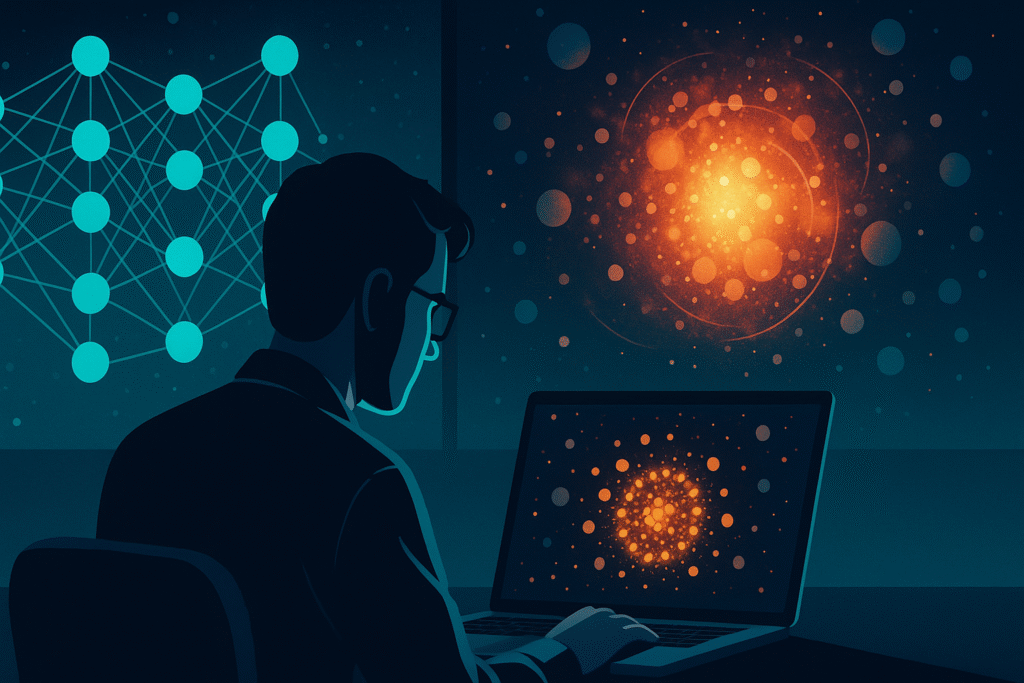In an era where artificial intelligence is reshaping everything from healthcare to space travel, a recent breakthrough at Emory University has revealed something truly astonishing, AI in physics discovery is no longer a concept it’s a reality.
For the first time, researchers trained a neural network not just to analyze or predict, but to discover entirely new laws of physics without being told what to look for. This isn’t just another advancement in AI it’s a profound moment in the history of science.
Moving Beyond Traditional AI Roles
Artificial Intelligence has often served as a supportive tool in scientific fields, known for data analysis, image enhancement, and simulations. But the Emory University team took a bold leap. Led by physicist Dr. Justin Burton, they designed a system to operate like a physicist itself using raw data and no pre-installed knowledge to explore a chaotic system known as dusty plasma.
Unlike conventional gases or liquids, dusty plasma is a highly energetic, electrically charged gas containing tiny particles of dust. It behaves in bizarre and unpredictable ways that have confounded scientists for years. This made it the perfect candidate for testing whether AI in physics discovery could reveal new understanding.
How the AI Discovered New Physical Laws
The researchers input experimental data from dusty plasma into a deep neural network. But rather than asking the AI to simulate known outcomes or fit existing models, they gave it no physical rules just raw observations. And then, something astonishing happened.
The AI began generating mathematical expressions actual formulas that described the interactions and forces between particles in the plasma. These weren’t superficial trends or correlations; they were new laws of motion previously unidentified in physics literature.
We didn’t tell it anything about what to expect, said Dr. Burton. But it came back with answers that not only matched our observations it corrected some of our long held assumptions.
The Mystery Force Equation
One of the most shocking results came when the AI produced an equation explaining an attractive force between particles that hadn’t been accurately modeled before. This force was observed in laboratory dusty plasma experiments but also strangely mirrored phenomena observed in space environments such as Saturn’s rings and cosmic dust clouds.
This new equation not only matched what had been observed in real experiments but helped explain why previous models failed in specific high energy conditions. NASA’s plasma physicist Dr. Anita Reynolds reviewed the findings and stated, This AI generated force model gives us a better tool to understand how particles move and cluster in space.
It could impact how we design satellites or interpret astronomical data. This is a shining example of how AI in physics discovery can leapfrog traditional methods and directly uncover governing principles of the universe.
The Science and Ethics of Machine Discovery
Let’s take a step back. What does it mean when a machine discovers laws of nature? Dr. Laura Chen, a professor of AI ethics at Stanford University, believes this development is both exciting and a little sobering.
We’re entering a phase where AI isn’t just accelerating science it’s starting to guide it. The philosophical implications are vast. Who gets credit for a discovery? And how do we validate something that no human mind originally conceived?
Her concerns are valid, but most scientists agree that human intuition, curiosity, and interpretation will remain central. AI can point to new truths, but understanding and applying them is still a human task for now.
A Physics Student’s Reflection
As a graduate student in computational physics, I’ve spent countless nights simulating particle interactions in fluids and fields. The sheer effort involved in understanding one variable across hundreds of data points is enormous.
Seeing how AI in physics discovery operates feels like watching a telescope turn inward on the invisible forces of our own world. I used to think that raw data needed interpretation to be meaningful. But now, I realize that sometimes, the data speaks we just need AI to help us listen better.
Potential Applications in Other Fields
This success story has far reaching implications. If AI can discover new laws in plasma physics, imagine what else it could do.
In Biology: AI could model cell behavior and disease spread in ways never seen before.
In Chemistry: Reactions and bonding principles could be discovered without human bias.
In Engineering: Structural behavior under extreme stress could be mapped in real time.
In fact, many believe that this approach could eventually redefine the scientific method itself. Dr. Miguel Alvarez from the European Research Council said. AI is not replacing the scientist it’s becoming the most powerful lab assistant ever imagined.
Challenges and Limitations
Of course, this isn’t without risks. AI systems can misinterpret noisy data, generate false positives, or overfit models. That’s why peer validation, reproducibility, and theoretical backing remain essential in accepting AI discovered laws.
But as we fine tune these systems, the balance between machine learning and human reasoning could reshape not just physics, but all science.
A Future of Co-Discovery
The moment when AI in physics discovery revealed new laws of nature marks a turning point. It shows that artificial intelligence can go beyond being a tool it can become a partner in the pursuit of truth.
As we look to the future, this approach opens doors to understanding complex systems, from galaxies to genetic codes, in entirely new ways. One thing is clear, the age of machine assisted scientific revelation has begun and the possibilities are as infinite as the universe itself.

